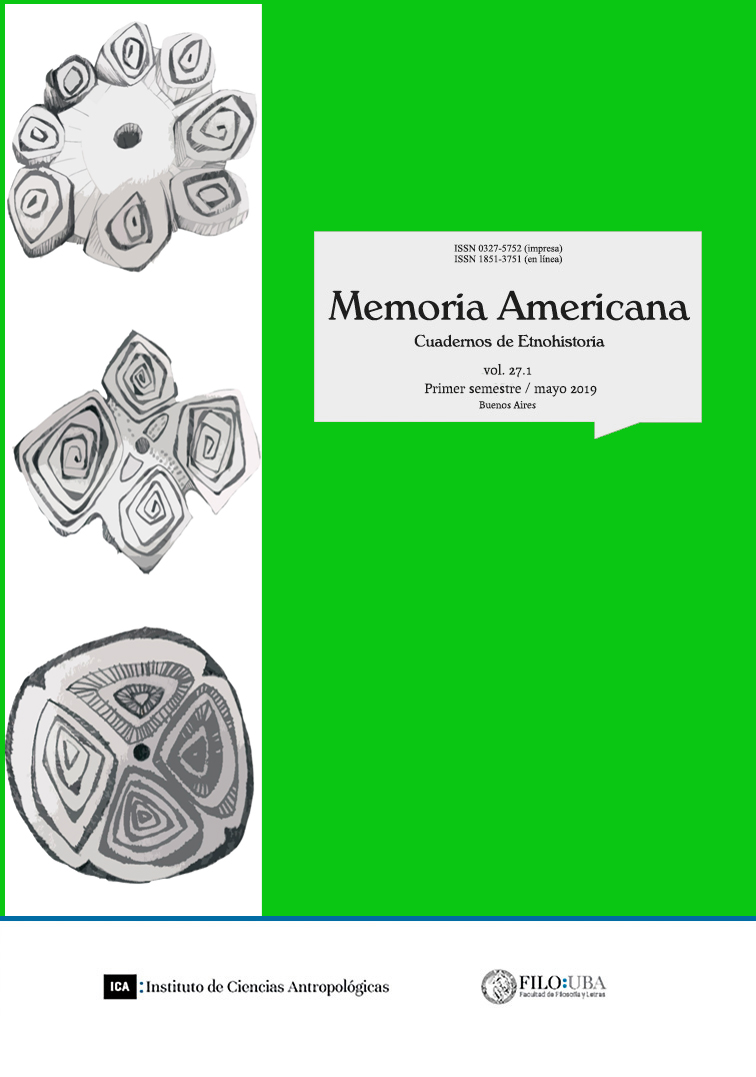Hierbas medicinales y semiosis colonial: Ilustraciones indígenas en dos manuscritos novohispanos sobre la naturaleza americana del siglo XVI
Resumen
El presente artículo propone una relectura del herbario elaborado por el “médico” Martín De la Cruz, traducido al latín por Juan Badiano en 1552, y “el tratado médico” que forma parte del Códice Florentino de Bernandino de Sahagún (1577), a partir de la noción de semiosis colonial. La calidad mixta de estos artefactos -estar conformada por imágenes y textos- y la participación directa de los sabios náhuatl, habilita considerar las representaciones visuales de las hierbas medicinales como enunciados portadores de cierta autonomía, pese a estar inscritos dentro de los géneros de representación europea. Esta particularidad pone en tensión la supuesta subordinación de los significantes visuales al imperativo de la escritura alfabética, dando cabida a valorar la presencia de representaciones heterogéneas en el contexto de la alfabetización mesoamericana en el siglo XVI.Descargas
Citas
Afanador Llanch, M. J. (2011). Nombrar y representar: escritura y naturaleza en el Códice de la Cruz-Badiano, 1552. Fronteras de la Historia 16: 13-41.
Anderson, F. J. (1997). An Ilustrated History of the Herbals. Nueva York, Columbia University Press.
Appadurai, A. (1991). “Introducción: las mercancías y la política del valor” en Appadurai, A. (Ed.), La Vida Social De Las Cosas. Perspectivas culturales de la mercancía: 17-88. México, Grijalbo.
Bauer, A. (2002). Somos lo que compramos. Historia de la cultura material en América Latina. México, Taurus.
Bernand, C. y S. Gruzinski (2005). Historia del Nuevo Mundo. Tomo II. Los mestizajes, 1550-1640. México, Fondo de Cultura Económica.
Bleichmar, D. (2015). The imperial visual archive: images, evidence, and knowledge in the early modern Hispanic world. Colonial Latin American Review 24: 236-266.
Cañizarez-Esguerra, J. (2006). Nature, Empire, And Nation. Stanford, Stanford University Press.
Cummins, T. (2004). Brindis con el Inca. La abstracción andina y las imágenes coloniales de los queros. Lima, Universidad Nacional Mayor de San Marcos - Universidad Mayor de San Andrés - Embajada de los Estados Unidos de América.
Del Pozo, E. C. (1996). “Valor médico y documental del manuscrito” en De la Cruz, M. Libellus De Medicinalibus Indorum Herbis. Manuscrito Azteca De 1552. Según traducción latina de Juan Badiano: 329-348. México, Fondo de Cultura Económica - Instituto Mexicano Del Seguro Social.
Descola, Ph. (2001). “Construyendo naturalezas. Ecología simbólica y práctica social” en Descola, Ph. y G. Pálsson (coords.), Naturaleza y sociedad. Perspectivas antropológicas: 101-123. México, Siglo XXI.
Duverger, Ch. (1996). La conversión de los indios de Nueva España. Con el texto de los Coloquios de los Doce de Bernandino de Sahagún (1564). México, Fondo de Cultura Económica.
Elliott, B. (2011). The World of the Renaissance herbal. Renaissance Studies 24: 24-41.
Foucault, M. ([1969] 2008). La arqueología del saber. Buenos Aires, Siglo XXI.
Foucault, M. ([1973] 1987). El orden del discurso. Barcelona, Tusquets.
Gruzinski, S. (2010). Las cuatro partes del mundo. Historia de una mundialización. México, Fondo de Cultura Económica.
Gruzinski, S. (2013). La colonización de lo imaginario. Sociedades indígenas y occidentalización en el México español. Siglos XVI-XVIII. México, Fondo de Cultura Económica.
Klor de Alva, J. J. (1992). “El discurso nahua y la apropiación de lo europeo” en León Portilla, M.; Gutiérrez Estévez, M., H. Gossen, G. y J. J. Klor de Alva (eds.), De Palabra y Obra En El Nuevo Mundo 1. Imágenes interétnicas: 339-368. Madrid, Siglo XXI.
Laird, A. (2014). Nahuas and Caesars: Classical Learning and Bilingualism in Post-Conquest Mexico: An Inventory of Latin writings by Authors of the Native Nobility. Classical Philology 109: 150-169.
Lamana, G. (2016). Dominación Sin Dominio. El Encuentro Inca-español En El Perú Colonia Temprano. Perú, IFEA - Centro Bartolomé de las Casas.
León Portilla, M. (2003). Literaturas Indígenas De México. México, Fondo de Cultura Económica - MAPFRE.
León Portilla, M. (2012). La riqueza semántica de los códices mesoamericanos. Estudios De Cultura Náhuatl 42: 139-160.
López Austin, A. (2012). Cuerpo Humano E Ideología. Las concepciones de los antiguos nahuas. México, Universidad Nacional Autónoma de México - Instituto De Investigaciones Antropológicas.
Magaloni Kerpel, D. (2014). Los Colores Del Nuevo Mundo. Artistas, materiales y la creación del Códice Florentino. México, Universidad Nacional Autónoma de México - The Getty Research Institute.
Martínez, J. L. (1981). “Prólogo” en Sahagún, B. D. El México Antiguo: IX- CII. Venezuela, Ed. Ayacucho.
Martínez, J. L. (2009). Registros andinos al margen de la escritura: el arte rupestre colonial. Boletín del Museo Chileno de Arte Precolombino 14: 9-25.
Mignolo, W. (1992). “La semiosis colonial: la dialéctica entre representaciones fracturadas y hermenéuticas pluritópicas” en González Stephan, B. y L. H. Costigan (eds.), Crítica y descolonización: el sujeto en la cultura latinoamericana: 27-47. Caracas, Universidad Simón Bolivar - The Ohio State University.
Mignolo, W. (1994). The Darker Side of Renaissance. Ann Harbor, Michigan University Press.
Mitchell, W. J. T. (2009). Teoría de la imagen. Madrid, Akal.
Morales Sarabia, A. (2014). “Tres caminos posibles: una ausencia, una marca tipográfica y un evento fortuito. El peyote y otras hierbas en la Materia Médica (Siglos XVI-XVII)” en Pardo-Tomás, J. y M. Sánchez Menchero (eds.), Geografías Médicas. Orillas y Fronteras Culturales De La Medicina (Siglos XVI Y XVII): 47-74. México, Universidad Nacional Autónoma de México, Centro de Investigaciones Interdisciplinarias en Ciencias y Humanidades.
O’ Gorman, E. ([1958] 2004). La invención de América. Investigación acerca de la estructura histórica del nuevo mundo y del sentido de su devenir. México, Fondo de Cultura Económica.
Ortiz de Montellano, B. (1993). Medicina, Salud y Nutrición Aztecas. México, Siglo XXI.
Pardo-Tomás, J. (2016). “Making Natural History in New Spain, 1525-1590”. Wendt, H. (ed.), The Globalization of Knowledge in the Iberian Colonial World: 29-51. Alemania, Max Planck Research Library for the History and Development of Knowledge, Proceedings 8.
Real Academia Española. (2014) Diccionario de la lengua española. 23ª edición. Madrid, España.
Rama, Á. (2004). La ciudad letrada. Santiago, Tajamar Editores.
Rey Bueno, M. (2004). Junta de herbolarios y tertulias espagíricas: el círculo cortesano de Diego de Cortavila (1597-1657). DYNAMIS 24: 243-267.
Reyes Equiguas, S. (2016). “El scriptorium del Colegio de la Santa Cruz de Tlatelolco a través de los códices Florentino y De la Cruz-Badiano” en Hernández, E. y P. Máynez (eds.), El Colegio de Tlatelolco. Síntesis de historias, lenguas y culturas: 26-38. México, Editorial Grupo Destiempos.
Russo, A. (2005). El Realismo Circular. Tierras, Espacios y Paisajes De La Cartografía Indígena Novohispana. Siglos XVI y XVII. México, Universidad Autónoma de México, Instituto de Investigaciones Estéticas.
Todorov. T. (1987). La Conquista de América. El problema del otro. Buenos Aires, Siglo XXI.
Turner, G. (2007). El Códice de la Cruz-Badiano y su extensa familia herbaria. Historias 68: 109-122.
Trabulse, E. (1992). Historia De La Ciencia En México. Estudios y textos. Siglo XVI. México, Conacyt - Fondo de Cultura Económica.
Verón, E. (1993). La semiosis social. Fragmentos de una teoría de la discursividad. Barcelona, Gedisa.
Viesca Triviño, C. (1995). “El Códice De la Cruz-Badiano, primer ejemplo de una medicina mestiza” en Fresquet, J. L. y J. M. López Piñero (eds.), El mestizaje cultural y la medicina novohispana del siglo XVI: 71-90. Valencia, Universitat de València - CSIC.
Zetina, S., Falcón, T. Arroyo, E., y J. L. Ruvalcaba (2011). “The Encoded Languaje of Herbs: Material Insights into the De la Cruz-Badiano Codex” en Wolf, G. y J. Connors (eds.), Colors Between Two Worlds. The Florentine Codex Of Bernardino De Sahagún: 221-256. Italia, Kunsthistorisches Institut in Florenz, Max-Planck Institut -Villa I Tatti, The Hardvard University Center for Italian Renaissance Studies.
Los derechos de autor son cedidos a Memoria Americana. Cuadernos de Etnohistoria, no obstante los autores podrán recuperarlos y reproducir su trabajo en otros medios o formatos previo envío de solicitud al Comité Editorial. En tales casos, deberá citarse a Memoria Americana. Cuadernos de Etnohistoria como primera publicación del trabajo y el mismo queda bajo una licencia Creative Commons CC BY NC SA 3.0 Attribution- Non Commercial -ShareAlike 3.0, la cual provee libre acceso inmediato a sus contenidos pues se rige por el principio según el cual hacer disponible -en forma gratuita- la investigación al público fomenta un mayor intercambio de conocimiento a nivel global.
Los autores deberán remitir el siguiente formulario de cesión de derechos y compromiso de originalidad:
Cesión de derechos y compromiso de originalidad
Al Comité Editorial de Memoria Americana, Cuadernos de Etnohistoria
Por la presente declaro ser el autor del trabajo titulado (nombre del artículo), el mismo es original y propio y no ha sido publicado en ningún formato o soporte con anterioridad.
En caso de ser aceptado para su publicación en Memoria Americana. Cuadernos de Etnohistoria (número/año) cedo los derechos editoriales que me corresponden por el aludido artículo para su publicación en todos los formatos que posea la mencionada revista.
Si quisiera publicar este artículo a través de otro editor o en otro lugar me comprometo a solicitar el correspondiente permiso por escrito al Comité Editorial de Memoria Americana. Cuadernos de Etnohistoria. De ser afirmativa la respuesta del Comité Editorial me comprometo a lo siguiente:
- especificar lugar, editorial y fecha de la primera publicación del artículo en la nueva publicación
- realizar esta republicación sólo luego de transcurridos un año calendario desde la fecha de la presente nota de cesión de derechos
FIRMA
Aclaración












